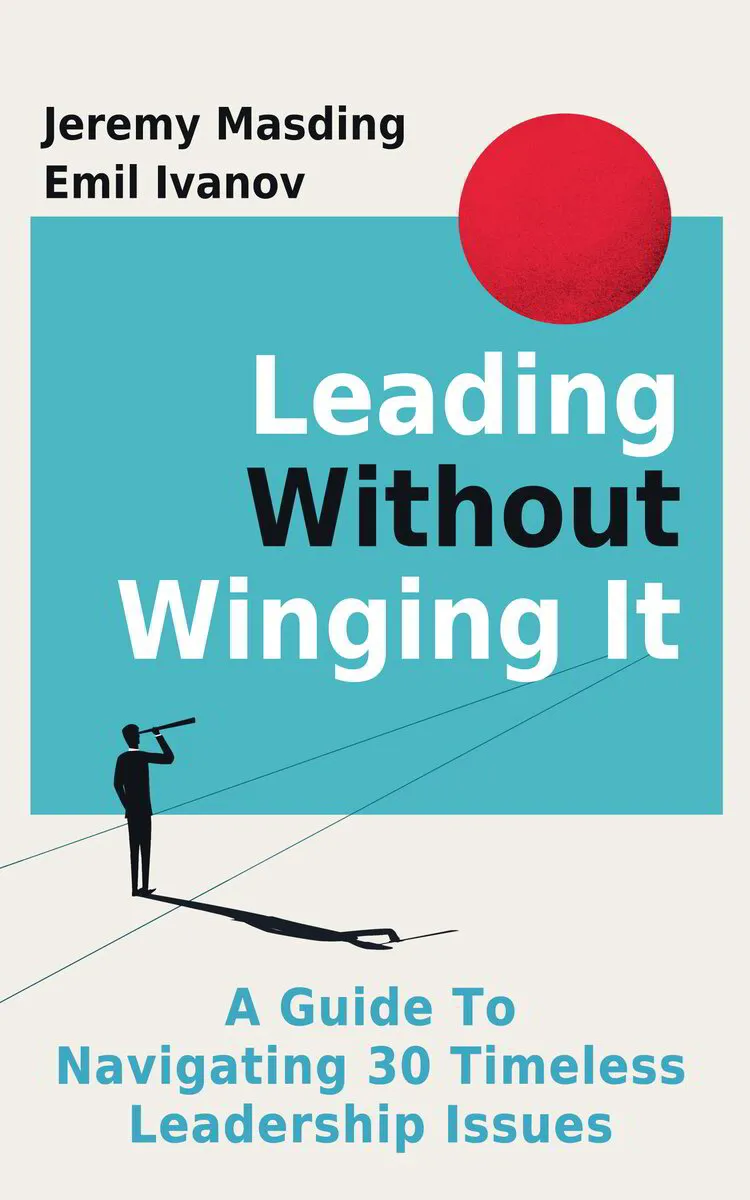Praise For The Book
Kevin Wall
Retired CEO of Barclays Bank Europe
Over the course of a number of decades I have read (sometimes only partially!) many books purportedly imparting lessons on “leadership”. About half of these are ego-trips by the writer with little of practical value for others, the other circa 50% are sleep inducing tomes with - again- little of practical value.
'Leading Without Winging It' is in that very small set of leadership publications that combines what to me are the key ingredients of an engaging read on this topic:
- Written by authors who have stumbled, failed, succeeded, learnt and reflected on their own hands-on leadership journey ie they have winged it as all effective leaders have
- Utilises lessons drawn from reality in order to apply the key learnings from the book
- Has a style of communication that is direct, honest and non-preachy
- Can be dipped into rather than requiring a “start to finish” commitment by the reader
Shane O'Sullivan
CEO (Interim) at the Irish Management Institute
‘Leading Without Winging It’ is an aide-memoire that every leader aspiring to greatness should read … and then keep very close to hand.
The authors have earned medals and scars through years of being at the leadership coalface. ‘Leading Without Winging It’ captures their critical insights and offers a practical framework and guide to those navigating a route to great leadership.
POW! Purposeful, Original, Wise. A mini-MBA from two practitioners with a deep understanding of leadership and track records of success at the coalface.
Matt Symonds
CEO Advisor and Former Partner at Bain & Co.
‘Leading Without Winging It’ is an essential guide to personal and organisational full potential, written by two leaders with the credentials and scars to have something meaningful to say about the territory. It’s filled with practical and actionable ideas about getting the best out of others, self and the organisation.
I recommend it to any ambitious leader, at any stage of their career.
Dr. Wieke Scholten
Behavioural Risk Specialist, BR Insights B.V
Jeremy Masding and Emil Ivanov are realists: they have done a fantastic job in writing a book that is honest about the highs and lows of leading an organisation.
The book covers a wide range of aspects of leadership, is unpretentious and generous in offering practical advice that encourages the reader to go out there and lead sensibly!
The book is a must read for all existing and aspiring leaders, general managers, and CEOs who want to increase their chances of leading successful and valuable businesses.
In everyday language, ‘winging it’ refers to the act of attempting to achieve a goal with minimal preparation or knowledge, making it up, or figuring it out on the fly. While this approach can be valuable in some situations requiring quick reactions and fast thinking, it will more often than not result in decisions and actions that are suboptimal and not as well thought out as they should be. The phenomenon of ‘winging it’ is widespread in the business world leading, inevitably, to higher risk and uncertainty.
In this seminal book, Jeremy Masding and Emil Ivanov provide a practitioners’ guide to leading a business that significantly reduces the number of times one has to wing it. This book shows aspiring CEOs and general managers how to maximise the sustainable value of their business by realising the full potential of good people, good thinking and good doing.
Building on many years of creating value, Masding and Ivanov offer a system for running any enterprise in a way that will capture both ‘hearts’ and ‘minds’. Using a logical construct based on both rational and emotional foundations, the authors offer ways of working for senior leaders that are easy to understand and very implementable.
Masding and Ivanov make a compelling case for focusing on value creation at every level of an organisation but are pragmatic in how this should be implemented to ensure full buy-in around this objective. They are candid in the use of examples, both good and bad, to illustrate the concepts and provide an objective view of the principles and tools therein.
The book is structured around a set of thirty recurring or ‘timeless’ questions, which everyone who has accepted the challenge of leading is likely to encounter over the course of their career. Whilst the book can be read as a reference guide to help with a particular topical question, its real strength is displayed fully when it is read and applied as a comprehensive management system.
As with all successful partnerships, we are two very different people. It is those differences that have enabled us to debate, to disagree, to agree and, ultimately, to develop a partnership that brings out the best in us both. We have worked together for over 25 years with a shared passion for learning, developing, and creating value for the organisations that we’ve worked in.
Jeremy Masding is forthright, demanding, and driven with a deep passion for leading, winning and making a difference whilst wanting to work (and develop) good people to be the best they can be.
He is motivated by the difficult job, the impossible task, or the broken business that needs mending. He does not enjoy ‘business as usual’. Jeremy wants to work with good people to fix, to build and to embed the highest standards of thinking and doing. He takes enormous pride in building something sustainable, greater than the sum of its parts and that has real impact.
In addition, Jeremy is a passionate believer in the power of management science and disciplined approaches to work. He believes that ‘shoddy thinking leads to shoddy doing’ and expects a lot from the people that work with him. At the same time, he does this in a way that allows colleagues to develop and live up to their fullest potential.
When reflecting on his motivations behind the book, Jeremy observed:
“I understand there are many different definitions of leadership. However, the one I use the most is that ‘leadership is giving your colleagues a choice about whether to be part of the business or not’. As such, I wanted to be wholly transparent (and grounded) in explaining our core beliefs and being clear about how we would run a business.
I wanted to give something back and offer a clear, practical, and actionable toolkit to help leaders of all experience levels to be the best they can. I want the book to offer a different perspective, a modern view of shareholder capitalism, that protects the primacy of equity capital whilst thinking deeply about how it should work in practice without widespread collateral damage. If this book challenges people to think or questions the emerging status quo, then mission accomplished”.
Emil Ivanov is reflective, thoughtful, inquisitive, caring, and smart. He is comfortable strategising, building, implementing, influencing, and subtly making a key difference in business context. Emil has an academic mind and is constantly thinking about and testing new ideas and concepts. He has always been deeply interested in management science, i.e., how companies work and how business people behave – covering the complete spectrum from the rational to the emotional side of business and from visions to management systems. Emil understands clearly how the rational and emotional interconnect and is skilled in developing and embedding the required toolkits that enable other people to think and do better.
He is a deep thinker who thrives on detail, insight and solving problems. Emil’s active intellect is accompanied by creativity and action. He can mix ‘thinking and doing’ in equal measure – this is a rare superpower in this day and age.
In addition, Emil is a keen student of human – with a strong ability to identify narcissistic and self-defeating behaviour. Emil is motivated by collaboration and teamwork that is underpinned by a robust management system.
When reflecting on his motivations behind the co-authoring this book, Emil observed:
“I have always been driven by understanding the inner workings of business, leading, managing, and interacting with people. I wanted to share my learnings and experiences in the simplest of terms – the big leadership issues, the principles to be applied in solving the issues, the positive actions that can be taken towards that end, and the pitfalls to be avoided.
If this book helps people make better decisions, take the right actions, and, critically, do so in a way that is underpinned by personal integrity, compassionate candour and without a blinding ego, then we have achieved successfully what we set out to do.”
About Us
Jeremy Masding
Jeremy left school at 18 with a desire to lead. Over the next 40 years, Jeremy built his career through a combination of learning by doing, taking challenging roles, investing in education, and delivering results. By observing many different definitions of leadership, involving both good and bad practices, Jeremy went from cashier to CEO developing a leadership framework that could be applied successfully across a wide variety of roles and businesses. It is this framework, which evolved and strengthened in partnership with Emil over nearly 25 years of working together, that underpins this book. It offers a clear, practical, and actionable approach to help leaders of all experience levels be the best they can be.
Jeremy most recently used the framework when brought in to rescue Permanent TSB PLC, one of Ireland’s biggest banks, which was nationalised in 2011 during the banking crisis. According to one newspaper “[Masding] inherited one of Europe’s worst banks when he took the job in 2012. The Welshman somehow managed to keep the show on the road… [and] saved an institution from collapse.”
Jeremy is an Associate and Fellow of the Chartered Institute of Bankers, a Certified Bank Director and holds an MBA from Manchester Business School.
Emil Ivanov
Emil is an experienced business leader with a strong background in the financial services industry. His expertise covers strategy, planning, change management, and investor relations. He is recognised for his leadership abilities, strong analytical skills, and attention to detail. Emil is also known for his ability to build and inspire high-performing teams, achieving exceptional results. He has always been driven by the deep desire to understand the inner workings of business, leading, managing, and the dynamics of interacting with people.
Emil’s partnership with Jeremy in writing this book has been driven by a simple mission: to share their learnings and experiences in the simplest of terms – the big leadership issues, the principles to be applied in solving the issues, the positive actions that can be taken towards that end, and the pitfalls to be avoided.
Emil is fascinated by why people do what they do, especially if it does not serve them or the business positively in the long-term. As a keen student of human behaviour Emil’s aim is to inspire others to push past their limitations and, pursue personal and professional growth.
Emil holds an MBA from INSEAD and a bachelor's degree from the American University in Bulgaria. He is also a Fellow of the Association of Chartered Certified Accountants.
Section 1: Creating an Organisational Blueprint
Here we discuss the foundational building blocks that any company with aspirations for high performance must put in place. These include Governing Objective, Vision, and Management Model. Collectively, we call them the ‘Organisational Blueprint’. The Organisational Blueprint is the backbone or fuselage of high-performance organisations. By necessity, it has a structure and rigidity to it. Around it, though, is an opportunity for both creativity and flexibility. For example, the Blueprint works equally well in start-up, scale-up, transformation, or business-as-usual corporate scenarios, yet very different management styles and strategies are required for each.
1. The Governing Objective: What Is It For Your Company?
2. The Vision: How To Set A Compelling Vision For Your Company
3. The Management Model: How To Define And Operate An Effective Management Model
4. Strategy Or Execution: Which Is More Important?
5. ‘Gaming’ The Planning Process: How To Avoid It
6. Decision-Making: How To Ensure It Is Effective
7. Customer Value: How To Focus On Your Customers?
8. Investor Relations: How To Be Good At It
9. Value Creation: How To Measure It
Section 2: Shaping the Organisation
Here we set out the key structures and processes required to give a company direction and momentum. The most important topics in this section are Organisational Structure and Resourcing, Organisational Culture, and Operating Rhythm.
10. Structure: How To Set An Effective Organisational Structure
11. Culture: How To Use Organisational Culture To Facilitate Change
12. Operating Rhythm: Why It Is Important And How To Set It
13. Corporate Communications: How To Communicate Effectively
14. Meetings: How To Conduct Them Effectively
15. Consultants: When To Use Them, Or Not
Section 3: Managing Oneself
Here we argue that one of the most important prerequisites of leading, motivating, and managing others is the ability to manage oneself. The key topics discussed in this section include setting the right personal priorities and managing personal time and energy effectively.
16. Priorities Management: How To Set The Right Personal Priorities
17. Time Management: How To Manage Your Time Effectively
18. Energy Management: How To Manage Your Energy Effectively
Section 4: Managing Others
Finally, we focus on developing one’s leadership toolkit for managing others. The key topics included here are finding the best people for your company, embedding high-performance teams, using Reward and Recognition in the most effective way, adapting your management style to the situation at hand, and addressing the most common interpersonal conflicts in a constructive and effective way.
19. Recruitment: How To Source And Select The Best People For Your Company
20. High-Performing Teams: How To Embed High-Performing Teams Effectively
21. Complex Stakeholders: How To Deal With Regulators And Boards Effectively
22. Performance Management: How To Manage Performance Effectively
23. Reward And Recognition: How To Set Reward And Recognition
24. Management Style: Authoritarian Or Participative Management Style?
25. Crisis Management: How To Manage Effectively In A Crisis
26. Silent Disagreement: How To Deal With It
27. Stress: How To Recognise It And Deal With It Effectively
28. Narcissistic Behaviours: How To Deal With Them Effectively
29. Interpersonal Rivalry: How To Deal With It Effectively
30. Dismissals: How To Let People Go Without Complications
Subscribe to Our Newsletter
By clicking submit you agree to our Terms of Service and Privacy and Cookie Policy.
You Can Contact Us Here
By clicking submit you agree to our Terms of Service and Privacy and Cookie Policy.
Copyright © 2023 Jeremy Masding & Emil Ivanov. All Rights Reserved.













